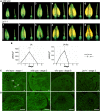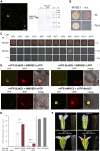Tomato MYB21 Acts in Ovules to Mediate Jasmonate-Regulated Fertility
- PMID: 30894458
- PMCID: PMC6533027
- DOI: 10.1105/tpc.18.00978
Tomato MYB21 Acts in Ovules to Mediate Jasmonate-Regulated Fertility
Abstract
The function of the plant hormone jasmonic acid (JA) in the development of tomato (Solanum lycopersicum) flowers was analyzed with a mutant defective in JA perception (jasmonate-insensitive1-1, jai1-1). In contrast with Arabidopsis (Arabidopsis thaliana) JA-insensitive plants, which are male sterile, the tomato jai1-1 mutant is female sterile, with major defects in female development. To identify putative JA-dependent regulatory components, we performed transcriptomics on ovules from flowers at three developmental stages from wild type and jai1-1 mutants. One of the strongly downregulated genes in jai1-1 encodes the MYB transcription factor SlMYB21. Its Arabidopsis ortholog plays a crucial role in JA-regulated stamen development. SlMYB21 was shown here to exhibit transcription factor activity in yeast, to interact with SlJAZ9 in yeast and in planta, and to complement Arabidopsis myb21-5 To analyze SlMYB21 function, we generated clustered regularly interspaced short palindromic repeats(CRISPR)/CRISPR associated protein 9 (Cas9) mutants and identified a mutant by Targeting Induced Local Lesions in Genomes (TILLING). These mutants showed female sterility, corroborating a function of MYB21 in tomato ovule development. Transcriptomics analysis of wild type, jai1-1, and myb21-2 carpels revealed processes that might be controlled by SlMYB21. The data suggest positive regulation of JA biosynthesis by SlMYB21, but negative regulation of auxin and gibberellins. The results demonstrate that SlMYB21 mediates at least partially the action of JA and might control the flower-to-fruit transition. .
© 2019 American Society of Plant Biologists. All rights reserved.
Figures









Similar articles
-
Jasmonic acid facilitates flower opening and floral organ development through the upregulated expression of SlMYB21 transcription factor in tomato.Biosci Biotechnol Biochem. 2018 Feb;82(2):292-303. doi: 10.1080/09168451.2017.1422107. Biosci Biotechnol Biochem. 2018. PMID: 29448919
-
The Jasmonate-ZIM domain proteins interact with the R2R3-MYB transcription factors MYB21 and MYB24 to affect Jasmonate-regulated stamen development in Arabidopsis.Plant Cell. 2011 Mar;23(3):1000-13. doi: 10.1105/tpc.111.083089. Epub 2011 Mar 29. Plant Cell. 2011. PMID: 21447791 Free PMC article.
-
Male sterility in Arabidopsis induced by overexpression of a MYC5-SRDX chimeric repressor.Plant J. 2015 Mar;81(6):849-60. doi: 10.1111/tpj.12776. Epub 2015 Feb 20. Plant J. 2015. PMID: 25627909
-
Gibberellin and jasmonate crosstalk during stamen development.J Integr Plant Biol. 2009 Dec;51(12):1064-70. doi: 10.1111/j.1744-7909.2009.00881.x. J Integr Plant Biol. 2009. PMID: 20021553 Review.
-
Jasmonate action and crosstalk in flower development and fertility.J Exp Bot. 2023 Feb 13;74(4):1186-1197. doi: 10.1093/jxb/erac251. J Exp Bot. 2023. PMID: 35670512 Review.
Cited by
-
AcoMYB4, an Ananas comosus L. MYB Transcription Factor, Functions in Osmotic Stress through Negative Regulation of ABA Signaling.Int J Mol Sci. 2020 Aug 10;21(16):5727. doi: 10.3390/ijms21165727. Int J Mol Sci. 2020. PMID: 32785037 Free PMC article.
-
The Ethylene Biosynthesis Gene CpACO1A: A New Player in the Regulation of Sex Determination and Female Flower Development in Cucurbita pepo.Front Plant Sci. 2022 Jan 24;12:817922. doi: 10.3389/fpls.2021.817922. eCollection 2021. Front Plant Sci. 2022. PMID: 35140733 Free PMC article.
-
CRISPR/Cas9-mediated editing of jasmonic acid pathways to enhance biotic & abiotic stress tolerance: An overview & prospects.Funct Integr Genomics. 2025 Jun 10;25(1):125. doi: 10.1007/s10142-025-01623-z. Funct Integr Genomics. 2025. PMID: 40493278 Review.
-
Development of pollinated and unpollinated ovules in Ginkgo biloba: unravelling the role of pollen in ovule tissue maturation.J Exp Bot. 2024 Jun 7;75(11):3351-3367. doi: 10.1093/jxb/erae102. J Exp Bot. 2024. PMID: 38459807 Free PMC article.
-
Multiomic analyses reveal key sectors of jasmonate-mediated defense responses in rice.Plant Cell. 2024 Sep 3;36(9):3362-3377. doi: 10.1093/plcell/koae159. Plant Cell. 2024. PMID: 38801741 Free PMC article.
References
Publication types
MeSH terms
Substances
LinkOut - more resources
Full Text Sources
Molecular Biology Databases
Research Materials

